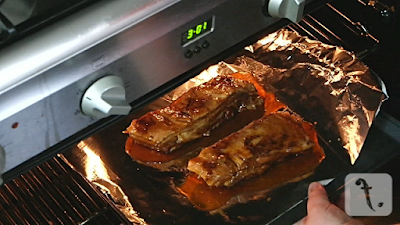3.05 Brioche & Butterscotch Pudding - Intermediate - Baking & Desserts
I was in a bit of a decadent mood one day, and having
recently seen an episode of Nigella Express where she made a Caramel Croissant
Pudding (a riff on Bread & Butter Pudding), I decided that something
similar would satisfy the urge. A couple of hours later, I was tucking into
this quite contentedly.
While "butterscotch" typically refers to a
mixture of butter and brown sugar, I decided to take it a bit more literally by
adding quite a large amount of scotch whisky (apparently anything labelled
"whiskey" is not authentic scotch). There is a fair bit of fire
involved in burning off the alcohol, and even then it doesn't all evaporate, so
I would recommend that you do not use a non-stick saucepan to make the custard
base.
Due to the booze content that lingers even after baking,
I will leave it up to you to decide whether it is acceptable to give to your
children or not.
Ingredients:
1 loaf Brioche, cut into cubes
200ml scotch whisky
500ml milk
75g unsalted butter
2/3 cup caster sugar
1 cup dark chocolate buttons
2 whole eggs
4 egg yolks
1 tsp vanilla extract/essence/paste
Pinch of salt
In regards to the Brioche, the cubes should be approx.
2.5 cm, (or 1 inch). If possible, it should also be slightly stale (as in a
couple of days after it was baked) as the more it dries out, the more custard
it will absorb. Most loaves are around 450-550g (approx. 1lb).
If you don't want to use scotch, you can use Irish
whiskey, bourbon, rum, etc. I've also made it with Baileys and another time
with Frangelico, but this will change the flavour a bit. If you want to leave
the alcohol out altogether (spoilsport) just use some extra milk.
As mentioned above, "butterscotch" is meant to
be butter and brown sugar, however I have opted to use caster sugar (which is
sweeter) to smooth the edge off the alcohol. If you're leaving out the alcohol,
feel free to use 2/3 cup of brown sugar instead. If you can find raw caster
sugar, this is a good compromise as it has all the sweetness of plain caster
sugar with a hint of caramel reminiscent of brown sugar.
Method:
1. Preheat oven to 180°C (350°F).
2. Tumble half of the cubed brioche into a baking dish,
then scatter over half of the chocolate buttons.
3. Repeat Step 2 with the remaining brioche and
chocolate.
4. Melt the butter in a saucepan over medium heat, then
stir in the sugar until combined and it begins to change colour and crystalise. (You'll be adding
liquid which will dissolve any lumps.)
5. Pour in the whisky. (TIP: You may want to do this off
the heat as it can catch fire right away if you're using a gas stove.)
6. Either set it alight (carefully) and swirl the pan
until the flames stop, or allow to simmer for at least 5 minutes, stirring
frequently. (Fire can tend to scorch the pan, hence the reason not to use
non-stick.)
7. Once the alcohol is burnt off, stir in the milk until
combined, then remove from the heat.
8. In a jug, whisk together the eggs (including the extra
yolks), vanilla and a pinch of salt until combined, then whisk in the hot milk
and whisky mixture until combined.
9. Slowly pour the custard mix over the brioche and
chocolate, ensuring that it is as evenly distributed as possible, then press
down the brioche so that it submerges in the custard as much as it can.
10. Allow to rest for 5-10 minutes. (This allows the
brioche to absorb the custard.)
11. Place into the oven and bake for 35-45 minutes or
until the custard is set and the top is golden brown.
12. Allow to cool for at least 15 minutes before serving
with some whipped cream or ice cream.
Serves 2-8 (being realistic!).
A video of this recipe is also available - https://youtu.be/DFyhHJWC0HA.



























